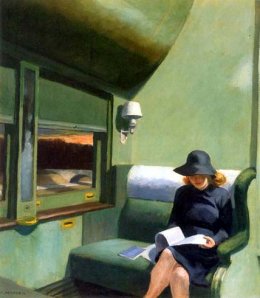Staging
"Staging" refers to everything that helps create the look, sound, and feel of a play for the audience. This would include...
Scenery
The first thing the audience sees when the curtain opens is the stage set itself; this often sets the tone for the play. For example, in Almost, Maine, the audience sees a an outdoor bench; it is snowing, and the lights of the stars are bright. There is no sign of buildings. The illusion of cold is emphasized, and indeed, in the scene, the cold weather and isolation reflect the conflict between the two characters, who want to be close but drive each other away. Thus, Cariani is giving the audience clues to the themes of the play from the very first moment.
Props
"Properties" (props for short) are the items placed on the set or used by the actors. They, too, can serve a purpose beyond the practical. In Post-its, for example, there are few props: just the chairs and the post-it notes the characters are holding. This minimalism draws attention to the themes of the play: the passage of time, communication (or the lack of it), love and loss.
Costumes
Costumes often establish the historical setting, the social background of the character, and the character's qualities. For example, in Scene 1 of Almost, Maine, East is wearing a warm coat over plaid pajamas and slippers or untied boots. He is casual, unprepared, but practical. All of these qualities serve him well in the scene.
Music
Music can help create a mood, or it can symbolize a memory of a previous time, as it often does in A Streetcar Named Desire, for example, when Blanche hears the "Varsouviana."
Sound Effects
These are any deliberately created noises, other than the actors' voices or the music. They, too, can have more import than the practical. In Asteroid Belt, for example, there is a loud crash at the end of the play. The sound signals a dramatic turn in the lives of everyone involved.When you are watching a play, of course, you will see or hear all of these things; when reading it, you will see, in the play, stage directions, instructions and descriptions that the playwright has written to help create the look and atmosphere he or she wants. Sometimes these stage directions are very simple; other times, as in Tennessee Williams, for example, they are elaborate and detailed, and help establish the themes and symbols of the play.
